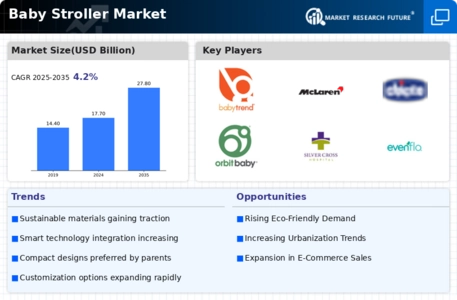Growing Urbanization
Urbanization plays a pivotal role in shaping the Global Baby Stroller Market Industry. As more individuals migrate to urban areas, the demand for convenient and compact baby transportation solutions rises. Urban parents often seek strollers that are lightweight and easy to maneuver in crowded spaces. This shift in lifestyle preferences is likely to drive innovation in stroller design, catering to the needs of urban dwellers. The market is projected to reach 27.8 USD Billion by 2035, reflecting the influence of urbanization on consumer choices and the overall growth of the industry.
Increasing Birth Rates
The Global Baby Stroller Market Industry experiences growth driven by rising birth rates in various regions. Countries such as India and Nigeria are witnessing significant population increases, which directly correlates with the demand for baby products, including strollers. As more families are formed, the necessity for reliable and safe transportation for infants becomes paramount. This trend is expected to contribute to the market's expansion, with projections indicating a market value of 17.7 USD Billion in 2024. The increasing number of births creates a larger consumer base, thereby enhancing the overall market dynamics.
Rising Disposable Income
The Global Baby Stroller Market Industry benefits from the increasing disposable income of families worldwide. As economic conditions improve, parents are more willing to invest in high-quality baby products, including premium strollers. This trend is particularly evident in developing countries, where a growing middle class is emerging. Higher disposable income allows families to prioritize safety, comfort, and style when selecting strollers. Consequently, the market is poised for growth, with an expected valuation of 17.7 USD Billion in 2024, reflecting the changing spending habits of consumers in the baby product sector.
Market Growth Projections
The Global Baby Stroller Market Industry is projected to experience substantial growth over the coming years. With a market value anticipated to reach 17.7 USD Billion in 2024 and further expand to 27.8 USD Billion by 2035, the industry is poised for a robust trajectory. The compound annual growth rate (CAGR) of 4.21% from 2025 to 2035 indicates a steady increase in demand for baby strollers. This growth is driven by various factors, including rising birth rates, urbanization, and technological advancements, all contributing to a dynamic market landscape.
Technological Advancements
Technological innovations are transforming the Global Baby Stroller Market Industry, leading to enhanced safety and convenience features. Manufacturers are increasingly integrating smart technologies, such as GPS tracking and automated folding mechanisms, into stroller designs. These advancements not only improve user experience but also address safety concerns, making strollers more appealing to tech-savvy parents. As the industry evolves, the incorporation of these technologies is expected to attract a broader consumer base, further driving market growth. The anticipated CAGR of 4.21% from 2025 to 2035 underscores the potential for ongoing innovation in this sector.
Health and Safety Awareness
Health and safety awareness among parents significantly influences the Global Baby Stroller Market Industry. Parents today are more informed about the importance of using safe and reliable baby products. This heightened awareness drives demand for strollers that meet stringent safety standards and regulations. Manufacturers are responding by ensuring their products undergo rigorous testing and certification processes. As a result, consumers are increasingly inclined to invest in strollers that prioritize safety features. This trend is likely to contribute to the market's growth, with projections indicating a market value of 27.8 USD Billion by 2035.












